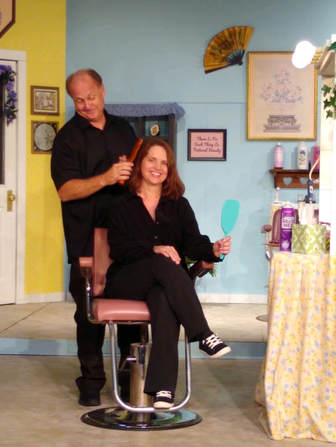 I haven't been doing a lot of writing these past two months. I had big plans this summer to finish my current novel and release my newest fairy tale novelette The Tomato Quest. This didn't happen. Why? Well, my other creative passion came calling. Theater. When she whispers in my ear, it's really hard to ignore her, especially when it's a great opportunity. This time around, I was asked to direct a production of Steel Magnolias at The Larry Keeton Theatre, a popular dinner theater in Nashville where I have performed over a dozen times. I couldn't resist the call and agreed to do it. So, I wound up spending all of July staging this play, and it opened last weekend for a three week run. My husband is stage managing, and I have decided to stick around and help with stage crew. I like staying involved, and it's fun to work with my husband (as you might tell from this silly picture of us on the set). 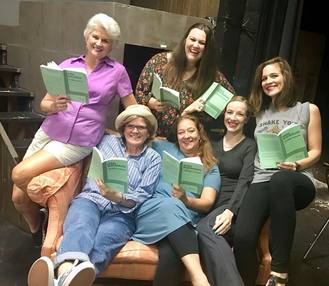 I've had an amazing cast, and directing this show has been a wonderful experience. I'm very glad I did it and have no regrets about taking time away from my writing... Well, let me think about this a little bit. Have I taken time away from my writing? I mean, it's true I haven't created any new words on my manuscript since June, but there are other aspects to being a writer besides the actual output of verbiage. A lot of it has to do with simply using my mind creatively with relation to telling a story. As I think back on the past month and a half of putting together a play, I notice that there are many similarities between writing a novel and directing a play. The main thing that is similar is how both of these creative outlets challenge my brain to think. 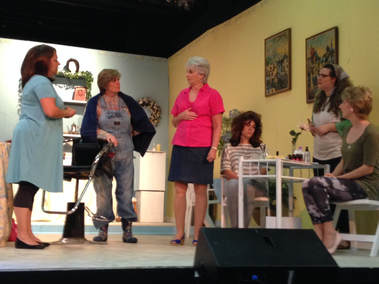 Blocking rehearsal for Steel Magnolias. Blocking rehearsal for Steel Magnolias. I think about story and plot. What is Steel Magnolias about? What happens? What is the best way to make each important moment in the play clear so that the audience will follow along and accept it all without question? When directing, I am interpreting someone else's writing, so these choices are made through blocking: moving the characters around on the stage to make interesting pictures, keeping the actresses' faces visible, varying the activity between serious and light moments, and adding business (what the actors do besides just reciting lines). The goal is to keep the action from being stagnant and boring the audience. As a writer, I use these same tools. I decide when and where my characters will stand, sit, or move. I carefully choose moments to share what they are doing with their faces, arms, and bodies. I try very hard not to make these movements random and to keep enough description so the reader can always visualize the scene and stay invested.  A beauty shop needs "hairdo" pics. This show is set in the 80s, so I couldn't resist putting my old 1989 Glamour Shots and one of my actress's old headshots on the wall. LOL! A beauty shop needs "hairdo" pics. This show is set in the 80s, so I couldn't resist putting my old 1989 Glamour Shots and one of my actress's old headshots on the wall. LOL! I think about the scenery. Steel Magnolias is set in one location - a beauty shop in the 1980s. Still, it has locations within it, such as the hair stations, manicure station, hair dryer, sink for washing hair, and exits. Based on the demands of the script, I chose how I wanted this shop to look, and then my husband and a team of workers built it for me. For Steel Magnolias, I wanted the set to be as realistic looking as possible, to make the audience feel completely involved in the show. As a writer, I make all of those same choices. I decide how the scenery looks - whether it's a teen girl's bedroom or a haunted rowboat in the middle of a dark, vast lake. I don't have anyone to build these sets for me, so I have to describe these locations in a way that the audience will be able to visualize it and stay connected to the story. 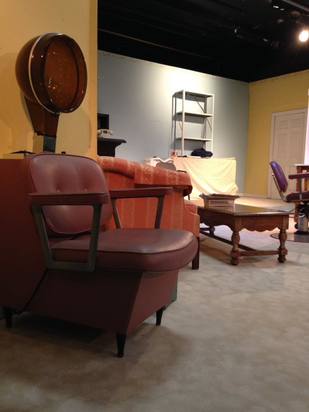 The set before we added any props or decoration. Boy, did it change! The set before we added any props or decoration. Boy, did it change! I think about properties. There are tons of items that the actresses have to use throughout the play from hair curlers, towels, mirrors, and nail polish, to extra stuff like magazines, pom-poms, candy, purses, and a tin of cookies to name a few. I had a wonderful woman helping me gather the props and decorate the set with them. She has a keen eye for things like this. Ultimately, though, it was my decision what we absolutely needed and how they would be used. Again, this is an important part of writing. I must decide when to mention something a character is holding or using. I describe it purposefully. The more attention I give the item, the more value it has to the plot or the character's identity. There is no point in introducing an object in a story or novel that is unnecessary. For example, if my main character uses a purse, that purse needs to suit her. In the play, Shelby's purse is pink and glittery, because she proclaims multiple times that she adores pink. "It's my signature color!" In my current work-in-progress, my main character's purse is small and plain because she doesn't like to draw attention to herself. Dannie, in Lost on the Water - A Ghost Story would never use a purse, preferring pockets, and Juniper Sawfeather chooses a messenger bag to take on her adventures. 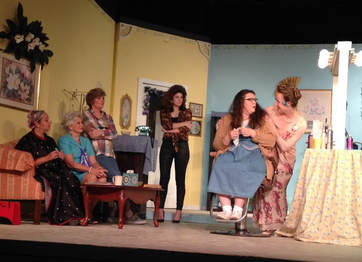 Dress Rehearsal for Steel Magnolias. Dress Rehearsal for Steel Magnolias. Then, ultimately, I think about the characters themselves, their motivations and intentions. I was blessed to have six incredible actresses to work with on Steel Magnolias. They have wonderful instincts and skill, and often I would wait to see what they would come up with on their own in rehearsals. Then, I just needed to shape it with some suggestions to alter the tone or delivery of a line. Or I might correct something that I interpreted differently. Sometimes I'd give an idea that would sharpen a comedic moment or prevent something from falling flat. In some ways this process of directing is more like revising a finished manuscript. It is no joke when authors say that characters often decide what they are going to say and do on their own. This happens to me all the time while writing first drafts. So, when I go back in to revise and rewrite, that's when I nudge that dialogue into place. It's often the time when all the 'he said' and 'she said' tags get changed into action lines or phrases that give more understanding of how the characters feel about what they're saying. So, in a sense, when I'm revising, I'm directing my characters to give their best performances. Perhaps that's why I prefer revising to writing first drafts. 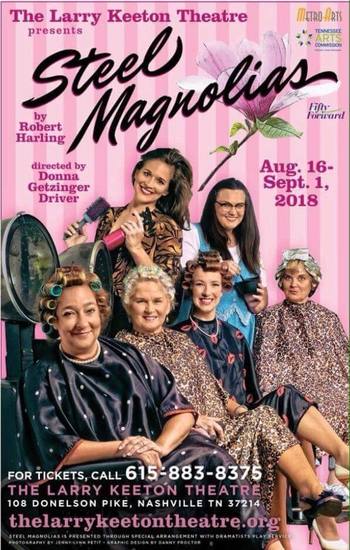 If you're in Middle TN and want to see this, click on this image. I think there are still some tickets for the final weekend. If you're in Middle TN and want to see this, click on this image. I think there are still some tickets for the final weekend. The final similarity I will point out is when the book is published or when the play is open, I sit back and wait for the response, crossing my fingers that people will like the finished product. I'm so proud to say that the response to Steel Magnolias has been awesome. One of our less forgiving critics in town praised it in his review, the ladies are getting much-deserved standing ovations, and the show is selling out all of its performances. I'll sum up by simply stating that directing this play has been an experience I won't forget. I'm not sure if being an author helped me be a better director or if being an actress/director helps my writing. A lot of people ask me which I prefer: acting or writing. I often joke that I like writing better because I get to play all the parts. This kind of goes for directing, too. Thanks for reading this post. I hope you enjoyed it and were able to take something away from it. If you did, please feel free to leave a comment. Also, take a moment to scroll through my blog or visit the other pages of my website. I had a bunch of new stuff release this summer, including an audiobook, a new novel, a story in a free anthology of fairy tales, and my newest fairy tale novelette The Tomato Quest, releases next weekend. Comments are closed.
|
D. G. DriverAward-winning author of books for teen and tween readers. Learn more about her and her writing at www.dgdriver.com Archives
July 2024
Categories
All
|
Author D. G. Driver's
Write and Rewrite Blog
“There are no bad stories, just ones that haven’t found their right words yet.”
A blog mostly about the process of revision with occasional guest posts, book reviews, and posts related to my books.
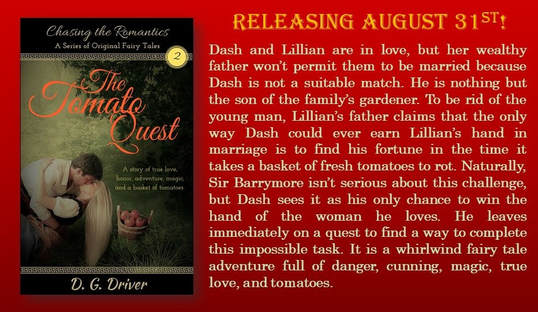

 RSS Feed
RSS Feed